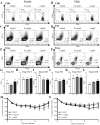Developmental Exposure to a Mixture of 23 Chemicals Associated With Unconventional Oil and Gas Operations Alters the Immune System of Mice
- PMID: 29718478
- PMCID: PMC5974794
- DOI: 10.1093/toxsci/kfy066
Developmental Exposure to a Mixture of 23 Chemicals Associated With Unconventional Oil and Gas Operations Alters the Immune System of Mice
Abstract
Chemicals used in unconventional oil and gas (UOG) operations have the potential to cause adverse biological effects, but this has not been thoroughly evaluated. A notable knowledge gap is their impact on development and function of the immune system. Herein, we report an investigation of whether developmental exposure to a mixture of chemicals associated with UOG operations affects the development and function of the immune system. We used a previously characterized mixture of 23 chemicals associated with UOG, and which was demonstrated to affect reproductive and developmental endpoints in mice. C57Bl/6 mice were maintained throughout pregnancy and during lactation on water containing two concentrations of this 23-chemical mixture, and the immune system of male and female adult offspring was assessed. We comprehensively examined the cellularity of primary and secondary immune organs, and used three different disease models to probe potential immune effects: house dust mite-induced allergic airway disease, influenza A virus infection, and experimental autoimmune encephalomyelitis (EAE). In all three disease models, developmental exposure altered frequencies of certain T cell sub-populations in female, but not male, offspring. Additionally, in the EAE model disease onset occurred earlier and was more severe in females. Our findings indicate that developmental exposure to this mixture had persistent immunological effects that differed by sex, and exacerbated responses in an experimental model of autoimmune encephalitis. These observations suggest that developmental exposure to complex mixtures of water contaminants, such as those derived from UOG operations, could contribute to immune dysregulation and disease later in life.
Figures





Similar articles
-
Developmental exposure to a mixture of unconventional oil and gas chemicals: A review of experimental effects on adult health, behavior, and disease.Mol Cell Endocrinol. 2020 Aug 1;513:110722. doi: 10.1016/j.mce.2020.110722. Epub 2020 Mar 5. Mol Cell Endocrinol. 2020. PMID: 32147523 Free PMC article. Review.
-
Water Contaminants Associated With Unconventional Oil and Gas Extraction Cause Immunotoxicity to Amphibian Tadpoles.Toxicol Sci. 2018 Nov 1;166(1):39-50. doi: 10.1093/toxsci/kfy179. Toxicol Sci. 2018. PMID: 30011011 Free PMC article.
-
Exposure to a mixture of 23 chemicals associated with unconventional oil and gas operations alters immune response to challenge in adult mice.J Immunotoxicol. 2021 Dec;18(1):105-117. doi: 10.1080/1547691X.2021.1965677. J Immunotoxicol. 2021. PMID: 34455897 Free PMC article.
-
Prenatal Exposure to Unconventional Oil and Gas Operation Chemical Mixtures Altered Mammary Gland Development in Adult Female Mice.Endocrinology. 2018 Mar 1;159(3):1277-1289. doi: 10.1210/en.2017-00866. Endocrinology. 2018. PMID: 29425295 Free PMC article.
-
Developmental and reproductive effects of chemicals associated with unconventional oil and natural gas operations.Rev Environ Health. 2014;29(4):307-18. doi: 10.1515/reveh-2014-0057. Rev Environ Health. 2014. PMID: 25478730 Review.
Cited by
-
Endocrine disrupting activities and geochemistry of water resources associated with unconventional oil and gas activity.Sci Total Environ. 2020 Dec 15;748:142236. doi: 10.1016/j.scitotenv.2020.142236. Epub 2020 Sep 8. Sci Total Environ. 2020. PMID: 33039138 Free PMC article.
-
Developmental exposure to a mixture of unconventional oil and gas chemicals: A review of experimental effects on adult health, behavior, and disease.Mol Cell Endocrinol. 2020 Aug 1;513:110722. doi: 10.1016/j.mce.2020.110722. Epub 2020 Mar 5. Mol Cell Endocrinol. 2020. PMID: 32147523 Free PMC article. Review.
-
Water Contaminants Associated With Unconventional Oil and Gas Extraction Cause Immunotoxicity to Amphibian Tadpoles.Toxicol Sci. 2018 Nov 1;166(1):39-50. doi: 10.1093/toxsci/kfy179. Toxicol Sci. 2018. PMID: 30011011 Free PMC article.
-
Developmental exposure to chemicals associated with unconventional oil and gas extraction alters immune homeostasis and viral immunity of the amphibian Xenopus.Sci Total Environ. 2019 Jun 25;671:644-654. doi: 10.1016/j.scitotenv.2019.03.395. Epub 2019 Mar 26. Sci Total Environ. 2019. PMID: 30939317 Free PMC article.
-
IMPACT OF REAL-LIFE ENVIRONMENTAL EXPOSURES ON REPRODUCTION: Evidence for reproductive health effects following exposure to hydraulic fracturing chemical mixtures.Reproduction. 2024 Sep 5;168(4):e240134. doi: 10.1530/REP-24-0134. Print 2024 Oct 1. Reproduction. 2024. PMID: 39074054 Review.
References
-
- Alvarez J. I., Saint-Laurent O., Godschalk A., Terouz S., Briels C., Larouche S., Bourbonniere L., Larochelle C., Prat A. (2015). Focal disturbances in the blood-brain barrier are associated with formation of neuroinflammatory lesions. Neurobiol. Dis. 74, 14–24. - PubMed
-
- Bahadar H., Abdollahi M., Maqbool F., Baeeri M., Niaz K. (2015). Mechanistic overview of immune modulatory effects of environmental toxicants. Inflamm. Allergy Drug Targets 13, 382–386. - PubMed
-
- Bahadar H., Mostafalou S., Abdollahi M. (2014). Current understandings and perspectives on non-cancer health effects of benzene: A global concern. Toxicol. Appl. Pharmacol. 276, 83–94. - PubMed
-
- Baines C. J., McKeown-Eyssen G. E., Riley N., Cole D. E., Marshall L., Loescher B., Jazmaji V. (2004). Case-control study of multiple chemical sensitivity, comparing haematology, biochemistry, vitamins and serum volatile organic compound measures. Occup. Med. (Lond.) 54, 408–418. - PubMed
Publication types
MeSH terms
Substances
Grants and funding
LinkOut - more resources
Full Text Sources
Other Literature Sources
Molecular Biology Databases
Miscellaneous

